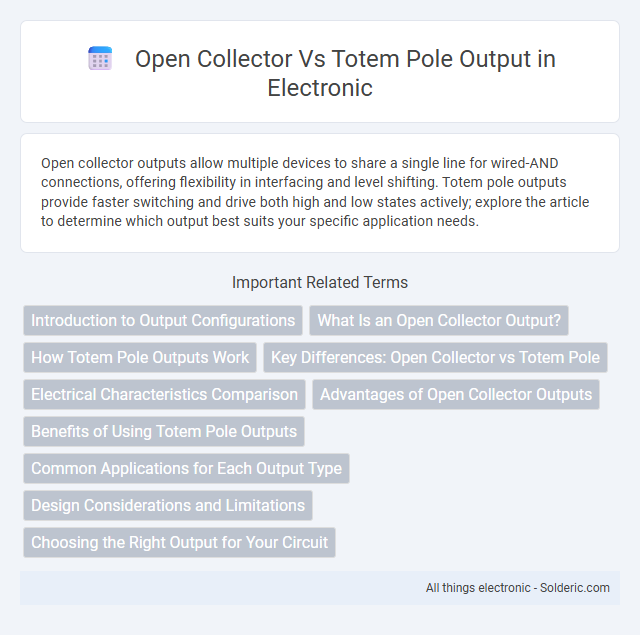Open collector outputs allow multiple devices to share a single line for wired-AND connections, offering flexibility in interfacing and level shifting. Totem pole outputs provide faster switching and drive both high and low states actively; explore the article to determine which output best suits your specific application needs.
Comparison Table
| Feature | Open Collector Output | Totem Pole Output |
|---|---|---|
| Structure | NPN transistor with open collector, requires external pull-up resistor | Complementary transistor pair (NPN and PNP) providing push-pull action |
| Output Type | Open-drain style, can only sink current | Push-pull, can sink and source current |
| Voltage Levels | Dependent on external pull-up voltage | Driven directly to supply voltage levels |
| Speed | Generally slower due to pull-up resistor RC time constant | Faster switching, suitable for high-speed signals |
| Wiring Flexibility | Supports wired-AND configurations, multiple outputs can be tied together | Does not support wired-AND; outputs should not be connected together |
| Power Consumption | Lower static power, as pull-up resistor limits current | Higher power consumption during switching due to active devices |
| Applications | Open-drain communication lines, wired-AND logic, level shifting | Standard logic outputs requiring driving capability and speed |
Introduction to Output Configurations
Open collector output configurations feature a transistor that can pull the output line to ground but requires an external pull-up resistor to achieve a high level, enabling wired-AND connections and level shifting. Totem pole outputs integrate both pull-up and pull-down transistors, allowing for actively driven high and low states, resulting in faster switching speeds and stronger drive capability. These fundamental differences influence power consumption, signal integrity, and interfacing options in digital circuits.
What Is an Open Collector Output?
An open collector output is a type of transistor output stage where the collector terminal is left open, allowing external components to pull the line to a desired voltage level. It requires an external pull-up resistor to establish the high logic level, enabling multiple outputs to be wired together for wired-AND logic functions. Understanding this setup is essential for designing circuits that need flexible voltage levels or shared bus lines, ensuring your signals are correctly interpreted.
How Totem Pole Outputs Work
Totem pole outputs use a pair of transistors arranged in a push-pull configuration to actively drive the output voltage both high and low, allowing faster switching speeds and stronger signal drive. This design ensures low output impedance, enabling Your devices to quickly charge or discharge the load capacitance, resulting in improved performance in digital circuits. Unlike open collector outputs, totem pole outputs do not require an external pull-up resistor, simplifying circuit design.
Key Differences: Open Collector vs Totem Pole
Open collector outputs use a transistor to pull the line low and require an external pull-up resistor to achieve a high state, enabling wired-AND connections and allowing multiple outputs to share the line safely. Totem pole outputs feature both push-pull transistors that actively drive the line high or low, providing faster switching speeds and stronger signal levels but preventing direct line sharing. Understanding these key differences helps you select the appropriate output type based on your circuit's need for speed, signal integrity, and multi-device communication.
Electrical Characteristics Comparison
Open collector outputs feature an external pull-up resistor, resulting in slower rise times but allowing flexible voltage levels and wired-AND configurations. Totem pole outputs have actively driven both high and low states with faster switching speeds and better noise immunity due to their push-pull transistor arrangement. Your choice depends on the need for speed versus versatility in interfacing with different voltage domains and logic levels.
Advantages of Open Collector Outputs
Open collector outputs offer the advantage of simple wired-AND logic connections, allowing multiple outputs to share a common bus without damage risks. These outputs provide flexibility in voltage levels since the external pull-up resistor sets the output voltage, enabling interface with various logic families and higher voltage loads. Your designs benefit from enhanced noise immunity and the ability to drive higher current and voltages than standard totem pole outputs.
Benefits of Using Totem Pole Outputs
Totem pole outputs provide faster switching speeds and stronger drive capability compared to open collector outputs, enabling improved performance in digital circuits. They can both source and sink current, allowing for full voltage swing and eliminating the need for external pull-up resistors, which simplifies circuit design and lowers component count. This makes totem pole outputs ideal for applications requiring high-speed signal transitions and direct interfacing with logic inputs.
Common Applications for Each Output Type
Open collector outputs are commonly used in applications requiring wired-AND logic, level shifting, or interfacing with higher voltages, such as driving LEDs, relays, and communication buses like I2C. Totem pole outputs are ideal for high-speed switching and driving loads directly with both sourcing and sinking capabilities, frequently found in microcontroller GPIO pins and digital logic circuits. Choosing the appropriate output impacts Your circuit's performance, especially in terms of speed, current capacity, and voltage compatibility.
Design Considerations and Limitations
Open collector outputs require external pull-up resistors to define the output voltage level, which impacts power consumption and speed due to resistor values and line capacitance. Totem pole outputs integrate both pull-up and pull-down transistors internally, enabling faster switching times and lower power dissipation but can cause issues like shoot-through current during transitions. Designers must consider load type, switching speed requirements, and compatibility with input stages when choosing between open collector and totem pole configurations.
Choosing the Right Output for Your Circuit
Open collector outputs allow multiple devices to share a single line for wired-AND logic and are ideal for interfacing with different voltage levels or implementing bus systems. Totem pole outputs provide faster switching speeds and actively drive both high and low states, making them suitable for high-speed digital circuits requiring strong drive capability. Selecting the right output depends on your circuit's need for speed, voltage compatibility, and line sharing functionality.
open collector vs totem pole output Infographic

 solderic.com
solderic.com